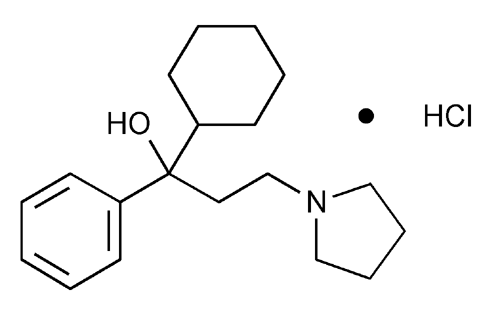Procyclidine Hydrochloride
1-Pyrrolidinepropanol,
» Procyclidine Hydrochloride contains not less than 99.0 percent and not more than 101.0 percent of C19H29NO·HCl, calculated on the dried basis.
Packaging and storage—
Preserve in tight, light-resistant containers, and store in a dry place.
USP Reference standards  11
11 —
—
USP Procyclidine Hydrochloride RS.
USP Procyclidine Hydrochloride RS.
Identification—
B:
Dissolve about 250 mg in 10 mL of water in a separator, render alkaline with 6 N ammonium hydroxide, and extract with three 10-mL portions of ether. Filter the ether extracts slowly through a layer of about 2 g of anhydrous granular sodium sulfate supported on glass wool, evaporate the ether with a current of warm air, and scratch the surface of the container to induce crystallization of the residue: the procyclidine so obtained melts between 83 and 87
and 87 , the procedure for Class I being used (see Melting Range or Temperature
, the procedure for Class I being used (see Melting Range or Temperature  741
741 ).
).
C:
A solution (1 in 100) responds to the tests for Chloride  191
191 .
.
pH  791
791 :
between 5.0 and 6.5, in a solution (1 in 100).
:
between 5.0 and 6.5, in a solution (1 in 100).
Loss on drying  731
731 —
Dry it in vacuum at 105
—
Dry it in vacuum at 105 for 4 hours: it loses not more than 0.5% of its weight.
for 4 hours: it loses not more than 0.5% of its weight.
Residue on ignition  281
281 :
not more than 0.1%.
:
not more than 0.1%.
Related compounds—
Dissolve approximately 200 mg of Procyclidine Hydrochloride in 20 mL of water, and render the solution alkaline by adding 1.5 mL of 6 N ammonium hydroxide. Extract with three 15-mL portions of chloroform, wash the combined extracts with 20 mL of water, discard the water washing, and filter the chloroform solution through a layer of 3 to 4 g of anhydrous granular sodium sulfate supported on glass wool. Reduce the volume to 5 mL by evaporating with the aid of gentle heat and a current of air. Inject 2 µL of this solution into a suitable gas chromatograph (see Chromatography  621
621 ) equipped with a flame-ionization detector, and record the chromatogram to 2.5 relative to the retention time of the principal (procyclidine) peak. Under typical conditions, the instrument contains a 1-m × 2-mm glass column packed with 10% polyethylene glycol 20,000 and 2% potassium hydroxide on packing S1A. The column is maintained at a temperature of about 180
) equipped with a flame-ionization detector, and record the chromatogram to 2.5 relative to the retention time of the principal (procyclidine) peak. Under typical conditions, the instrument contains a 1-m × 2-mm glass column packed with 10% polyethylene glycol 20,000 and 2% potassium hydroxide on packing S1A. The column is maintained at a temperature of about 180 , the injection port is maintained at 210
, the injection port is maintained at 210 , the detector block is maintained at about 220
, the detector block is maintained at about 220 , and dry helium is used as the carrier gas at a flow rate of about 60 mL per minute. From the total area under the curve, excluding the solvent peak, calculate the percentage of total impurities by area normalization: not more than 4.0% is found.
, and dry helium is used as the carrier gas at a flow rate of about 60 mL per minute. From the total area under the curve, excluding the solvent peak, calculate the percentage of total impurities by area normalization: not more than 4.0% is found.
Assay—
Dissolve about 700 mg of Procyclidine Hydrochloride, accurately weighed, in 75 mL of glacial acetic acid in a 250-mL beaker, warming, if necessary, to effect solution. Cool, add 10 mL of mercuric acetate TS, and titrate with 0.1 N perchloric acid VS, determining the endpoint potentiometrically. Perform a blank determination, and make any necessary correction. Each mL of 0.1 N perchloric acid is equivalent to 32.39 mg of C19H29NO·HCl.
Auxiliary Information—
Please check for your question in the FAQs before contacting USP.
Chromatographic Column—
| Topic/Question | Contact | Expert Committee |
| Monograph | Ravi Ravichandran, Ph.D.
Senior Scientist 1-301-816-8330 |
(MDPP05) Monograph Development-Psychiatrics and Psychoactives |
| Reference Standards | Lili Wang, Technical Services Scientist 1-301-816-8129 RSTech@usp.org |
USP32–NF27 Page 3398
Chromatographic columns text is not derived from, and not part of, USP 32 or NF 27.
